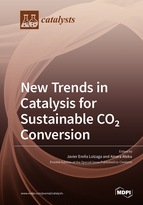New Trends in Catalysis for Sustainable CO2 Conversion
A special issue of Catalysts (ISSN 2073-4344). This special issue belongs to the section "Environmental Catalysis".
Deadline for manuscript submissions: closed (30 June 2022) | Viewed by 46296
Special Issue Editors
Interests: CO2 valorization; alternative fuels; syngas; catalysts and catalytic reactions; kinetic modeling; synthesis of methanol, dimethyl ether (DME), and hydrocarbons
Special Issues, Collections and Topics in MDPI journals
Interests: CO2 valorization; alternative fuels; syngas; catalysts and catalytic reactions; kinetic modeling; synthesis of methanol, dimethyl ether (DME), and hydrocarbons
Special Issues, Collections and Topics in MDPI journals
Special Issue Information
Dear Colleagues,
Over the past few decades, there have been many advances in the world, leading to the improvement of life quality. Due to demographic and industrial growth, consumption has increased, as well as the amount of wastes and contaminants. Today, global warming and climate change are mainly attributed to the emission of anthropogenic greenhouse gases, with carbon dioxide (CO2) being the most relevant one, due to the huge amount of emissions of this gas to the atmosphere (mainly derived from the consumption of fossil fuels).
Carbon capture and storage (CCS) is a physical process which consists of separating the CO2 (emitted by the industry and by the combustion processes for energy generation) and transporting it to a geological storage to isolate it from the atmosphere in the long term. However, the most promising routes for CO2 mitigation are those that use catalysts and chemical processes for valorization. By applying specific catalysts and suitable operating conditions, CO2 molecules react with other components to form longer chains (i.e., hydrocarbons). Accordingly, efforts should be made to catalytically valorize CO2 (alone or being co-fed with syngas), as an alternative way for reducing greenhouse gas emissions and obtaining high-value fuels and chemicals.
Carbon capture and utilization (CCU) is a developing field with significant demand for research in the following aspects:
- Development of new catalysts, catalytic routes, and technologies for CO2 valorization;
- Study of new processes for obtaining fuels and chemicals from CO2;
- Optimization of the catalyst and the reaction conditions for the process;
- Steps further on advanced processes for improving the amount of CO2 fed into the reactor (either alone or co-fed with syngas) and the yield of products.
Dr. Javier Ereña
Dr. Ainara Ateka Bilbao
Guest Editors
Manuscript Submission Information
Manuscripts should be submitted online at www.mdpi.com by registering and logging in to this website. Once you are registered, click here to go to the submission form. Manuscripts can be submitted until the deadline. All submissions that pass pre-check are peer-reviewed. Accepted papers will be published continuously in the journal (as soon as accepted) and will be listed together on the special issue website. Research articles, review articles as well as short communications are invited. For planned papers, a title and short abstract (about 100 words) can be sent to the Editorial Office for announcement on this website.
Submitted manuscripts should not have been published previously, nor be under consideration for publication elsewhere (except conference proceedings papers). All manuscripts are thoroughly refereed through a single-blind peer-review process. A guide for authors and other relevant information for submission of manuscripts is available on the Instructions for Authors page. Catalysts is an international peer-reviewed open access monthly journal published by MDPI.
Please visit the Instructions for Authors page before submitting a manuscript. The Article Processing Charge (APC) for publication in this open access journal is 2700 CHF (Swiss Francs). Submitted papers should be well formatted and use good English. Authors may use MDPI's English editing service prior to publication or during author revisions.
Keywords
- catalytic processes for CO2 transformation
- CO2 valorization
- carbon capture and storage (CCS)
- carbon capture and utilization (CCU)
- climate change mitigation
- synthesis of fuels and chemicals
- syngas







